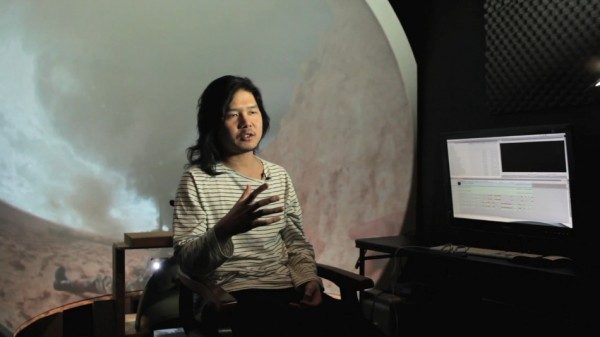 Condition One aims to achieve a standardized way of capturing and displaying immersive 180 degree video. The company is a startup founded by noted photographer Danfung Dennis. Currently the product takes the form of an iPad app in which the user can tilt the device or pan using a finger to look around the 180 degree view; Condition One’s work could provide a standard way for capturing high field of view content to be played back on high field of view head mounted displays like the Oculus Rift.
Condition One aims to achieve a standardized way of capturing and displaying immersive 180 degree video. The company is a startup founded by noted photographer Danfung Dennis. Currently the product takes the form of an iPad app in which the user can tilt the device or pan using a finger to look around the 180 degree view; Condition One’s work could provide a standard way for capturing high field of view content to be played back on high field of view head mounted displays like the Oculus Rift.
[vimeo http://www.vimeo.com/43867479 w=400&h=300]
Mark Cuban, entrepreneur and investor, has seeded $500 thousand dollars to Condition One to develop their platform.
Condition One says that their capture solution is ‘hardware agnostic’ and operates with existing video editing software and workflows:
Our solution does not rely on specialized hardware. We are a software company that leverages existing technologies. We believe bulky and expensive proprietary hardware to shoot immersive content is not a scalable solution for the long term.
Shooting immersive content has never been easier. We use cameras and lenses that are already on the market.
Editing Condition One content is exactly the same as editing standard video footage. You can continue to use Final Cut Pro, Avid Media Composer or any other video editing software.
Once footage has been finalized, the content is easily transformed and uploaded into the Condition One Video Player. Then the gyroscopes and accelerometers of the iPad/iPhone are transfixed to the content to provide the immersive window.
The last point is the one that I’d like to contest. Sure, a mobile device like the iPad creates an interesting viewport into the video content, but it’s not truly immersive and surrounding. You have to pretend that you’re in the scene by blocking out the real world around you and only focus on the device. If this Condition One content was instead adapted to a high field of view HMD like the Oculus Rift, the user would genuinely be immersed in a virtual reality world. Add surround sound recording an a pair of good headphones and the user would be transported to another place entirely.
Such standarized methods of capturing and playing back 180 degree / high FoV content is the first step toward immersive and interactive movie experiences that I wrote about back in November of last year:
Rather than seeing a couple argue emotionally in the kitchen from some predefined angle, imagine feeling like you’re sitting at the table right next to them. The emotion of the argument would be greatly enhanced thanks to you being quite literally ‘in medias res’.
Imagine how much more terrifying a scary movie would be where, thanks to surround sound, you can look in the direction of every creak, groan, and scream, or hear faint footsteps creeping up behind you only to find that there is nothing there.
How many times have you seen a movie where adventurers are exploring through a jungle when they come upon a rickety bridge spanning hundreds of feet of gorge, with a lethal drop below? Normally, the view you get in a movie is some aerial shot as the actors move across the bridge, but what if you were right there behind the adventurers, able to look down at your feet and see the terrifying chasm beneath you? That movie is suddenly far more immersive than it would be otherwise. This immersion provides a new tool for story-tellers to evoke emotion that plays on our own experiences, instincts, and fears. Again, we have the technology to make this happen today.
Early forms of interactive movies will likely be of the ‘on-rails’ variety (ie: you’ll be able to look around, but your path will be chosen for you). As the genre further developers, I can see the interaction quickly going one step further; allowing you to make decisions within the virtual environment and alter the path of the experience and the story.
The first person perspective is incredibly powerful. Imagine the scariest film you’ve ever seen. How many times did you wish that the character didn’t open a certain door, for you knew that something evil lurked within? Imagine how much more terrifying it would be to be in an immersive 180 degree perspetive where you are behind the eyes of the character opening that door, unable to control their actions, forced to watch what will unfold.
Imagine that instead of watching an interviewer talk to the president of the United States on TV, you take on the perspective of the interviewer thanks to a high FoV HMD. The President looks you right in the eyes to deliver an answer to the question.
The most powerful narratives the world will ever know will come from this sort of immersive cinematography, depending upon how they play their cards, Condition One could be the first company to help us break into that frontier.
via GigaOm






